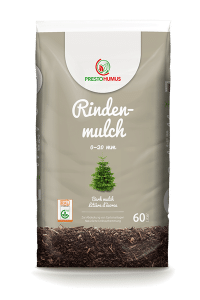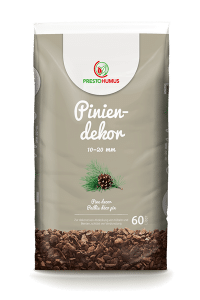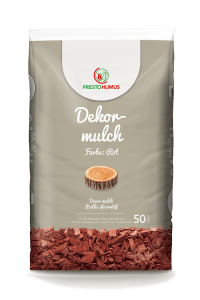Vegetation, dead plant parts, leaves and needles are a natural cover, protecting the soil against drying out and erosion. This natural mulch layer provides a microbial activity and gives protection against extreme weather conditions such as frost, heating and siltation. This kind of protection is often missing in our garden and for balcony and terrace plantings, tough it eases general gardening, cultivation and improves soil fertility.
Correct Mulching by 2 in 1: Attractive Optics & Protection
Mulch - types & application fields

pine mulch

coarse pine mulch

spruce & fir mulch

bark humus

wooden decor / woodchips

decor mulch
Using bark mulch
Helpful instructions for correct mulching with bark mulch
- For the application of bark mulch, it is advisable to remove any existing weeds and roots from the plant area or tub at the beginning.
- Then the mulch should be extensively spread – easily done by using a rake.
- For an adequate soil protection of beds and borders we recommend a mulch layer of at least 5 – 8 cm.
A layer of 3 – 5 cm in planters is necessary for a sufficient soil protection.
When creating a smooth garden path from bark mulch, a layer thickness of 10-12 cm should be considered. Mark the requested route, excavate the ground to a depth of approx. 15 cm, consider a slight incline of the path. A 3-5 cm drainage of lava mulch is important to be laid out and finally a top layer of bark mulch.
Handy hint: The larger the area to be covered the larger the grain size should be. When laying out beds a medium size of 10 – 40 mm is advisable. This is where the significantly reduced fine part of Presto Humus’ mulch products shows its positive effect.
About mulch
- Protection against physical impacts such as extreme weather conditions, high wind, harmful dehydration, cracking/crusting and excavation (erosion)
- Protection against excessive increase of soil temperature due to direct sunlight as well as siltation and flushing, both resulting from heavy rainfalls
- Micro-organisms are able to locate due the bark mulch, that also provides an improved and pro-longed decomposition activity of the soil
- Mulch supports humification, also a significant stabilization of the soil fertility can be noticed
- Reduction of evaporation – water-saving effect!
- Significant weeds’ reduction – more effective plant and garden care
Highly recommended is the use of mulch for vegetable beds as well as under bushes and hedges. In case of densely growing plants or dry soils you should check individually whether a layer makes sense or not.
For vegetable beds
Best mulching results of vegetable beds are received by taking shredded harvest residues, green manure crops, grass clippings, bark humus or leaves.
For fruits
Straw, wood wool, wood shavings or chips are most suitable for strawberries.
For flowers
Preferably use bark mulch of spruce, pure pine or a pine-based one for flower beds, herbaceous borders and woody plants.
For ericaceous plants
In order to receive best results for ericaceous plants - such as rhododendrons, heather plants and blueberries - bark humus (fermented bark mulch) should be used.
For hedges and woody plants
Hedges and woody plants could easily and cost-effectively protected by using spruce or fir mulch. Bark mulch is also very fine for garden paths, i.e. between compost heap and vegetable patches.
For rose beds
An excellent protection for rose beds is using rose mulch. The mulch’s fine structure and its dark colour are highlighting effectively the fresh green of the plants and their glowing blossoms.
For front yards & terraces
In the front yard and next to the terrace pine decor gives a very precious look due to its special structure, whereas the bark’s red colour gives a Mediterranean flair to the garden.
If you like to place any colour accents use wood decor made of barkless coniferous wood, being harmless for both humans and animals.
Depending on the field of application and purpose of use, you can choose from various mulch materials and grain/sieving sizes.
You are lucky, softwood bark can actively stunt weed growth of goutweed, thistles and couch grass amongst others. Tanning substances from the bark of pine or spruce are an effective blocker against germination. Positive result: most efficient garden care!
The fine particles lead to less compression so that the mulched area, beds or pots can absorb water more effectively. Too many fine bark particles break the oxygen exchange in the soil.
Product recommendations





